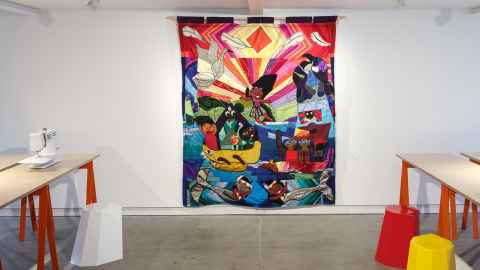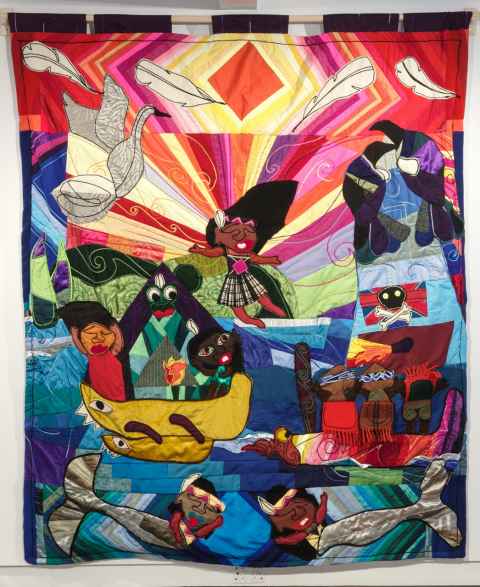Ron Te Kawa artwork celebrates fun, colour and magic of te ao Māori
2 June 2023
Ron Te Kawa’s unmissable quilted wall-hanging is a recent addition to the University of Auckland art collection.

If you have paid a visit to the Elam School of Fine Arts of late, you could not have missed the exuberant tapestry by contemporary artist Maungarongo ‘Ron’ Te Kawa (Ngāti Porou).
The Natives Must Be in Awe (2020) is a quilted wall-hanging and a recent addition to the University of Auckland art collection, acquired in late 2021 and joining a growing group of textile-based artworks that are part of the collection.
Ron Te Kawa lives in Woodville, Manawatū, though he has been working in fabric across the fashion, art and education sectors throughout Aotearoa for decades. He is a takatāpui (LGBTQI+) artist and is self-taught, first learning to sew from his father, who purchased a second-hand sewing machine when Ron was aged nine. Ron has been creating intricate textile works since the 1990s, and he uses his unique style of quilting as a conduit for storytelling.
Ron’s artworks explore mātauranga Māori (Māori knowledge) and his whakapapa and atua wāhine (female deities), through his characteristic use of bold colour and an illustrative style that brings scenes in his works to life. He sees the quilting as akin to tukutuku panels and in the past he created Aids memorial quilts when he was starting out.
The Natives Must Be in Awe is a striking example of Ron’s large-scale quilted banner works. The artwork was created in response to his shock at a sentiment he heard broadcast on air. When describing the work, Ron explained that he couldn’t believe it when he heard a host on a radio programme saying how, “The natives must have been in absolute awe when they saw the Endeavour sailing over the horizon.”
Adds Ron: “I know people from all around Gisborne and in their way of telling it, they were not in awe.”

Ron’s quilted wall artwork depicts a tongue-in-cheek representation of Māori (‘the natives’) encountering colonial explorers (represented by a ship sailing a flag, depicting a skull and crossbones over a Union Jack). Incorporated into the composition is a vibrant waka against a rainbow sky and many figures wearing tīpare (headbands). They are responding to the foreigners in the background from their focal position on the foregrounded moana, each with mouths poised in waiata.
The work was part of Ron’s solo exhibition Hīnātore: A Love Story: Ron Te Kawa at Objectspace (2021). In an accompanying text Ron explained, “Whakapapa quilts are an invitation to celebrate the fun, colour and magic of te ao Māori and all those things that fill my heart and heal my mind and spirit. Dance, connection to wairua and nature, whānau, whenua, stories, survival, resilience.”
The exhibition also incorporated a functioning sewing studio in the gallery space. Ron has long been involved in community projects and throughout the show, he held several sewing and textile whakapapa workshops within the gallery, for the public to learn alongside his artworks.
He is currently preparing a new body of work to take to Sápmi (Sweden and Norway) to share with the Sámi peoples later this year.
In 2021 Ron told Viva in The New Zealand Herald, that after being a fashion designer for 25 years, he’d wanted to work out a way to change careers but still include fashion. He started sewing figures onto clothes to protect the wearer.
“No one is gonna mess with you when you are wearing a Hine-nui-te-pō [the goddess of death] skirt or a jacket emblazoned with a fierce kaitiaki,” he said.
The celebration of contemporary textile and fabric practices, particularly those of Indigenous artists, has only come about in recent decades. Such practices were historically regarded as ‘crafts’ and not considered to be fine art in the same way that media such as painting or sculpture were.
This is reflected in the University’s art collection, in which textile-based works make up only around 25 of nearly 2,000 artworks, with the majority acquired in the past 15 years.
The Natives Must Be in Awe then, makes a tactile and welcome addition to the Waipapa Taumata Rau walls.
By Madeleine Gifford